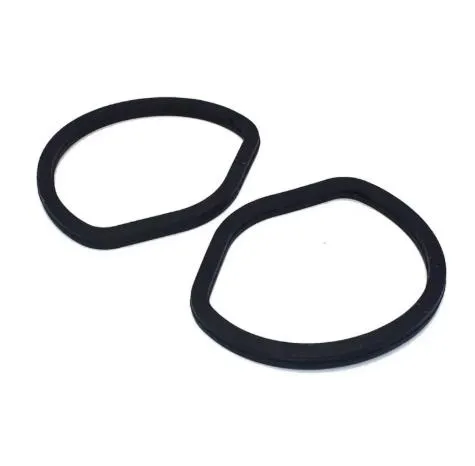Understanding the Importance of Oil Filter Housing Gaskets in Engine Maintenance
Proper engine maintenance is essential for vehicle longevity and performance. Among the many components that ensure smooth operation, gaskets—especially those connected to the oil system—play a crucial role. This article dives into five specific types of gaskets: the oil filter housing gasket, oil filter gasket, oil housing gasket, filter housing gasket, and oil cooler housing gasket. Understanding their functions and differences can help prevent costly engine damage and extend your vehicle’s life.

What Is an Oil Filter Housing Gasket?
The oil filter housing gasket is a seal between the oil filter housing and the engine block. The oil filter housing holds the oil filter in place and channels oil through it. Over time, this gasket can deteriorate due to heat, pressure, and exposure to engine oil.
Common Signs of a Failing Oil Filter Housing Gasket:
Oil leaks around the oil filter housing
Low oil pressure due to seepage
Engine overheating, as oil leaks may affect cooling
Visible oil residue near the engine or under the vehicle
A failed oil filter housing gasket can result in rapid oil loss, leading to engine wear or even failure. Replacing the gasket typically involves removing the housing, cleaning the surfaces, and installing a new gasket with proper torque to avoid future leaks.
Distinguishing the Oil Filter Gasket from Other Gaskets
Often confused with the oil filter housing gasket, the oil filter gasket is the rubber seal that comes attached to the oil filter itself. This gasket ensures a tight seal between the oil filter and the filter mount on the engine.
Key Points About Oil Filter Gaskets:
They are usually replaced every oil change, along with the filter
Over-tightening can crush the gasket, leading to leaks
Forgetting to remove the old gasket (a "double gasket") can also cause catastrophic oil leaks
Although smaller than the oil filter housing gasket, the oil filter gasket is equally important. Always lubricate the new gasket with clean oil and hand-tighten the filter to avoid damage.
The Role of Oil Housing and Filter Housing Gaskets
The terms oil housing gasket and filter housing gasket are sometimes used interchangeably, especially in online forums and parts catalogs. However, there are subtle differences depending on the vehicle design.
Oil Housing Gasket:
This gasket typically seals the entire oil housing unit to the engine block. The oil housing might contain several elements, including the oil filter, pressure sensors, and in some cases, the oil cooler. A worn oil housing gasket can lead to widespread oil seepage and loss of pressure.
Filter Housing Gasket:
This is a more general term that refers to any gasket sealing a housing containing a filter—not limited to oil. In the case of the engine oil system, the filter housing gasket refers to the seal between the oil filter housing and the engine. It's functionally very similar to the oil filter housing gasket.
Both gaskets play an important role in keeping the engine sealed, maintaining oil pressure, and preventing contamination. When replacing either, it’s crucial to clean all surfaces and avoid over-torquing bolts.
Oil Cooler Housing Gasket: A Hidden Weak Link
One of the more overlooked components in an engine’s oil system is the oil cooler housing gasket. This gasket seals the interface between the oil cooler and the engine or oil filter housing. Vehicles equipped with oil coolers—especially performance or towing vehicles—depend on this gasket to manage heat transfer.
Why It Matters:
If the oil cooler housing gasket fails, oil may mix with coolant or leak externally
Coolant contamination can lead to engine bearing failure
The oil cooler assembly can be buried under other components, making leaks hard to diagnose
Symptoms of failure often mimic those of other gasket issues—such as unexplained oil loss or visible residue. However, coolant in the oil or oil in the coolant reservoir is a telltale sign that the oil cooler housing gasket may be the culprit.
Final Thoughts: Prevention Is Better Than Repair
Each of these gaskets—oil filter housing gasket, oil filter gasket, oil housing gasket, filter housing gasket, and oil cooler housing gasket—plays a small but vital role in maintaining oil integrity, pressure, and cooling efficiency in an internal combustion engine.
Preventive Maintenance Tips:
Replace gaskets at the first sign of a leak
Never reuse old gaskets, even if they look intact
Use high-quality OEM or premium aftermarket parts
Regularly inspect around the oil filter housing and cooler for leaks
Keep track of oil levels and pressure for early detection of issues
By paying attention to these seemingly minor components, car owners and mechanics alike can avoid larger engine problems down the road. A small investment in gasket replacement can save thousands in engine repair.
-
Simplifying Oil Changes: A Comprehensive Guide to Oil Drain Plugs and Their Variants
Akụkọ Aug.04,2025
-
Mastering Oil Drain Maintenance: Solutions for Stripped, Worn, and Upgraded Oil Plugs
Akụkọ Aug.04,2025
-
Fixing Oil Pan Plug Issues: Leaks, Stripped Nuts, and the Right Replacement Solutions
Akụkọ Aug.04,2025
-
Everything You Need to Know About Oil Drain Plugs: Sizes, Fixes, and Upgrades
Akụkọ Aug.04,2025
-
Choosing the Right Oil Drain Plug: A Guide to Sizes, Materials, and Drain Innovations
Akụkọ Aug.04,2025
-
A Complete Guide to Automotive Drain Plugs: Types, Problems, and Innovative Solutions
Akụkọ Aug.04,2025
-
The Ultimate Guide to Car Repair Kits: Tools and Essentials Every Driver Should Own
Akụkọ Aug.01,2025
Ụdị ngwaahịa















